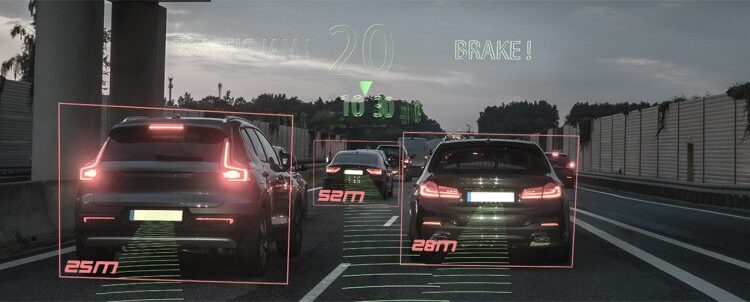The five levels of automation
Despite the hopes of some self-driving enthusiasts, most car manufacturers agree that fully-autonomous cars are quite a few years, or possibly decades, away. But on the way, we will experience gradually increasing levels of automation, starting with the more advanced driver assistance system that are already being explored by innovation-hungry car manufacturers. The different stages of automation are commonly divided into five, or six, levels, ranging from cars with no automation features to fully self-driving vehicles.
Level 0 – No automation. The car is manually driven by a human at all times.
Level 1 – Driver assistance. “Hands-on, eyes-on, mind-on”. An active driver is required at all times, but some driver assistance features like speed assist and autonomous emergency braking can help the driver with some aspects of driving.
Level 2 – Partial Automation. “Hands-on, eyes-on, mind-on”. Level 2 also includes more advanced driver assistance features, such as lane support and lane-keep assistance.
Level 3 – Conditional Automation. “Hands-off, eyes-on, mind-on”. By level 3, the automation mode allows the car to be self-driving at times, but still requires a human driver to be able to take over when needed. This creates the complicated issue of the “machine-to-human handover”, when the driver needs to be able to quickly retake control of the vehicle.
Level 4 – High automation. “Hands-off, eyes-off, mind-off”. Cars with level 4 automation can handle all driving situations, and the driver is free to text, close their eyes or do whatever they like.
Level 5 – Full automation. “Human-off”. By level 5, the car handles all situations, no matter how extreme or unpredictable, at all times. At this point, the steering wheel can primarily be seen as an optional feature.
Today, 90% of all cars occupying our roads are categorized as level 0, with no automation features. Over the next ten years, level 2 cars are expected to become the largest segment in terms of mass-market vehicles, while fully-autonomous cars are more likely to be decades away.
Autonomous driving – the key to safe roads or a dangerous experiment?
To say that the expectations on self-driving cars are high is an understatement. Besides fulfilling a lifelong fantasy for many car enthusiasts, autonomous driving is predicted to revolutionize road safety. There are researchers that claim driverless vehicles could reduce traffic fatalities by up to 90 percent by 2050. According to the World Health Organization, about 1.2 million people die in traffic accidents every year. Putting those two numbers together, we are looking at 10 million lives saved – every decade. Those are numbers that are hard to argue with.
But as we have already established, flawless driverless cars remain a faraway goal. We still have a long way to go; one that involves increasing levels of autonomy, offering their own risk reductions as well as safety challenges.
One of the most critical challenges of putting vehicles with conditional automation on the roads is the “machine-to-human handover”. According to a study conducted by the National Highway Traffic Safety Administration (NHTSA), it took some drivers up to 17 seconds to regain control of a semi-autonomous car as a difficult situation forced it to exit its autonomy mode. In order to fully grasp the security risk presented, 17 seconds equals more than 400 meters for a car traveling close to 100 km per hour. Additionally, the driver’s reaction to the system’s alert was even further delayed when the driver was engaged in other tasks, like typing a text.
This study demonstrates one of the most pressing causes of concern when discussing self-driving cars. In what is sometimes referred to as the paradox of automation, it seems that the more reliable an autonomous vehicle becomes, the less reliable its driver becomes. The more the driver trusts their car to manage the driving, the worse they are going to handle having to take over responsibility when required to. And this false sense of security has already proven to have potentially fatal consequences.
One of the most tragic, and most publicized, examples of over-confidence in an autonomous car is a fatal crash in Phoenix, USA. Last year a self-driving car in the form of a test vehicle struck a pedestrian, who later died from her injuries. The vehicle’s safety driver seems to have been streaming TV at the time of the crash, leaving the driving completely to the vehicle.
This crash is far from the only time an incident involving an autonomous car has cost human lives. For instance, testing of another autopilot system has so far resulted in several fatal crashes attributed to the driver’s over-confidence in the autopilot. So far, it seems like the biggest threat to the development of self-driving and inherently safer cars is, ironically, the human driver.
The solution
For all its flaws, it does not seem likely that either car manufacturers or consumers are going to give up on the dream of autonomous cars anytime soon. Nor should they; self-driving vehicles are the promise of both increased traffic safety and a more sustainable transportation industry. But if we are going to be able to trust a machine with our lives, we need to be absolutely guaranteed of its safety.
The semi-autonomous cars we will become familiar with in the foreseeable future will depend on an attentive driver to take control of the vehicle in situations too complex for the autonomous system to handle. But as demonstrated by recent crashes, human drivers easily become overly confident in the autonomous systems. To avoid that the road towards driverless cars becomes lined by fatal accidents, safety measures need to be taken.
A reliable driver monitoring system can turn a semi-autonomous vehicle into what it is intended to be, a dependable co-pilot to an attentive human driver, instead of an expensive safety risk. This is why eye tracking-based driver monitoring systems are already being widely adopted by car manufacturers developing vehicles operating at level 1, level 2, level 3 and level 4 autonomy. An advanced driver monitoring system allows for the next generation vehicles to make us better, safer drivers, rather than passive bystanders to a dangerous driving situation.



